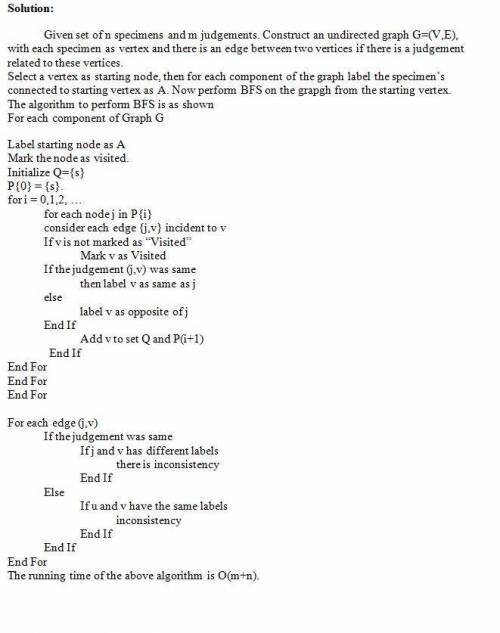
Engineering, 07.03.2020 03:32 surfer89
Inspired by the example of that great Cornellian, VladimirNabokov, some of your friends have become amateur lepidopterists (they study butter- flies). Often when they return from a trip with specimens of butterflies, it is very difficult for them to tell how many distinct species they’ve caught—thanks to the fact that many species look very similar to one another.
One day they return with n butterflies, and they believe that each belongs to one of two different species, which we’ll call A and B for purposes of this discussion. They’d like to divide the n specimens into two groups—those that belong to A and those that belong to B—but it’s very hard for them to directly label any one specimen. So they decide to adopt the following approach.
For each pair of specimens i and j, they study them carefully side by side. If they’re confident enough in their judgment, then they label the pair (i, j) either "same" (meaning they believe them both to come from the same species) or "different" (meaning they believe them to come from different species). They also have the option of rendering no judgment on a given pair, in which case we’ll call the pair ambiguous.
So now they have the collection of n specimens, as well as a collection of m judgments (either "same" or "different") for the pairs that were not declared to be ambiguous. They’d like to know if this data is consistent with the idea that each butterfly is from one of species A or B. So more concretely, we’ll declare the m judgments to be consistent if it is possible to label each specimen either A or B in such a way that for each pair (i, j) labeled "same," it is the case that i and j have the same label; and for each pair (i, j) labeled "different," it is the case that i and j have different labels. They’re in the middle of tediously working out whether their judgments are consistent, when one of them realizes that you probably have an algorithm that would answer this question right away.
Give an algorithm with running time O(m + n) that determines whether the m judgments are consistent.

Answers: 1
Another question on Engineering

Engineering, 03.07.2019 14:10
When at a point two solid phase changes to one solid phase on cooling then it is known as a) eutectoid point b) eutectic point c) peritectic point d) peritectoid point
Answers: 3

Engineering, 04.07.2019 18:10
The temperature of air decreases as it is compressed by an adiabatic compressor. a)- true b)- false
Answers: 2

Engineering, 04.07.2019 18:10
Abrake has a normal braking torque of 2.8 kip in and heat-dissipating cast-iron surfaces whose mass is 40 lbm. suppose a load is brought to rest in 8.0 s from an initial angular speed of 1600 rev/min using the normal braking torque; estimate the temperature rise of the heat dissipating surfaces.
Answers: 3

Engineering, 04.07.2019 18:10
Asingle-geared blanking press has a stroke of 200 mm and a rated capacity of 320 kn. a cam driven ram is assumed to be capable of delivering the full press load at constant force during the last 15 percent of a constant-velocity stroke. the camshaft has an average speed of 90 rev/min and is geared to the flywheel shaft at a 6: 1 ratio. the total work done is to include an allowance of 16 percent for friction a) estimate the maximum energy fluctuation b) find the rim weight for an effective diameter of 1.2 m and a coefficient of speed fluctuation of 0.10
Answers: 1
You know the right answer?
Inspired by the example of that great Cornellian, VladimirNabokov, some of your friends have become...
Questions


English, 16.06.2021 17:10

Mathematics, 16.06.2021 17:10


Mathematics, 16.06.2021 17:10

English, 16.06.2021 17:10

Mathematics, 16.06.2021 17:10






Social Studies, 16.06.2021 17:10

Mathematics, 16.06.2021 17:10


English, 16.06.2021 17:10


History, 16.06.2021 17:10





